Few men I know get my embroidery as presents. Then again there are probably very few men who would welcome an embroidered something, possibly anything, as a present. The recipient of this pillow case is, however, no run of the mill chap. An itinerant (and often homeless) scholar cut from an C18th pattern book, he has cultivated the rare talent of loving beautiful things (and knowing a great deal about them) without either needing to possess them – or, having possessed them for a time, he gives them away to others. Bruce grew up in a house full of fine things but circumstances dictated that few of these have come his way. An inveterate self inviter, his serendipitous appearances have something of the camel train about them as out of battered leather holdalls and woven tribal bags tumble exquisite (and even rather costly) presents, – scrumptious bits of speciality foods, handmade textiles, prints and pottery and, bashfully, as if they can’t possibly be good enough, the jams and chutneys he has made himself. Last time he stayed here he brought vanilla marmalade made to his mother’s recipe (a delicious combination – I had never considered vanilla and Seville oranges natural companions before) and a small velvet ikat cushion. His godchildren and friends alike often receive lengths of hand woven silks or tweeds and the wisest amongst them have them made up into jackets or shirts which inevitably end up as their favourite items of clothing.
Bruce’s wandering days are now fewer and for some 15 years he has established himself a base in an attic room on the top floor of a housing association house in York. This room is full of straining bookcases, the books that cause the problem for the bookcases, piles of papers, small objects of great interest, fine hand thrown pots, a few photographs … and a rather narrow bed. The communal dining room cum kitchen is notable for lovely pieces of tip rescued furniture, whose missing legs have been replaced by piles of books, and large pieces of pottery which when viewed from another angle can be seen to have substantial chips or cracks. Fastidiously clean and tidy without being slavish about the tidiness, I think Bruce shoulders the kitchen as his responsibility – although any severe fouling of this territory would I’m sure be challenged. Every week when not travelling, Bruce cooks a communal meal for anyone in the house at the time – the occupants have histories very different from Bruce’s own although all are united by having little money to their name. When Bruce has academic and scholarly friends round for a meal, members of the house join in too and as a visitor one gets the impression that this has been a force for peace and harmony and quite a degree of civilised living. Bruce’s influence continues into the little garden – a small Alhambra of sorts with roses trained over bean poles (along with the beans), discarded mirrors (cracks hidden by accommodating foliage giving reflections of unreliable perspective) and a giant shallow stoneware serving dish (with a flaw so fatal its previous owner had thrown it out) collecting water for the benefit of the local bird population. It is no surprise that Bruce won “Best Low Budget Garden” in the 2015 York Housing Association In Bloom Competition.
I first met Bruce at Oxford when I joined an ad hoc madrigal group informally brought together under his direction. He was always organising musical events and was well known for his elegant and civilised parties – mainly variants on the fête champêtre theme – his college rooms transformed into the countryside complete with shepherd (met on his travels in Germany), a lamb (belonging to the shepherd) and bales of hay. (I, probably invited by Bruce, or friend of Bruce’s, must have been at one of the earliest Piers Gaveston Society summer parties – innocent drinks in Oriel College with none of the shenanigans of later years as reported in the new David Cameron biography. And I was neither clever, nor even vaguely beautiful. But I digress). Bilingual (Belgian/English, brought up in England) Bruce studied Modern Languages and has a great facility with words and arcane bits of knowledge, none of which stops him from regularly saying “how do you say in English”. Few could usually supply the elusive word which he would later inevitably pluck from his own mind accompanied by a self effacing smile.
A group of us once met up in a cavernous Art Nouveau house in northern Italy and spent happy days getting on and off trains to interesting places on the line from Trento to Venice. Once, at Bergamo, I think, we split into two groups to go into the town which lay at the end of a long avenue of tall trees. My group visited the art gallery, walked around the town, had coffee with little sweet pastries and were back at the station at the appointed meeting time. Only with the sound of the train approaching, did tiny familiar figures come into view, breaking from a casual saunter into a run . The reason for their lateness was one of those serendipity things that just happen when you’re with Bruce. Seeing an elderly lady tending her plants (a contessa of course) Bruce stopped to chat about plants and was promptly invited up to the palazzo for tea… Some people just make their own serendipity … and go on making it. (On a family holiday in Egypt with my children and their father we were invited to a Nubian wedding. We hummed and haad to ourselves but in the end, too pathetic for adventure, could only lament “Bruce would have gone”).
For years Bruce travelled round all those bits of the Middle East now so out of bounds. He immersed himself in the cultural life of wherever he stayed and devoted himself to studying and translating all manner of things but most especially Persian mystical poetry. He was in Iran during the revolution and to begin with we would get letters from him saying there was an interesting rebellion in a nearby town, so he went to have a look. (No, Bruce, you leave… run in the opposite direction). The kidnapping and murder of his friend, Bahram Dehqani-Tafti, formerly an Oxford student and the son of the first Persian Anglican bishop of Isfahan was a severe blow and of course not long after Bruce left Iran; the poetry came with him and his work on that continued. After a brief period in England the travelling began again, at first a solitary traveller as before and then recently for specialist tour firms as tour guide and lecturer.
For some reason Bruce has never indulged in commercial writing about his travels. He earns just enough (I hope) to get by and then devotes himself to charitable work and scholarship. When my children were little he was always asking us to go to evenings of Afghan music in wonderful private houses and these we were always declining being at that period of child rearing when exhaustion takes over and travelling across London for an evening of possibly challenging music offers no overwhelming attraction. On one occasion he championed a North African tribe of dancers – or was it singers? – and found himself having to arrange legal representation when, after a family argument, one of them (at least) had killed another.
Of course it’s easy for those of us who have known Bruce for years to think of him as our pocket eccentric and not to see him in a larger context, so it is with delight that I discovered William Dalrymple (for whose last 3 books he has contributed research) refer to him as “the leading British scholar of C18th and C19th Persian” and that he has it in mind one day to make Bruce the subject of one of his books. In particular Dalrymple would like to write about Peshawar where Bruce lived in the 1980s, a time Dalrymple suspects when modern history was in the balance, military aid targeting the Pashtun tribes rather than those constituting the Northern Alliance and producing instability which set off the domino collapse whose end we have yet to see – the Soviet Union failed first in Afghanistan and then at home as communism collapsed, 9/11 awoke the West and the invasions of Iraq and Afghanistan. subsequently followed … And there in Peshawar was Bruce – putting on concerts, arranging poetry recitals, serving people delicious bits of this and that and quietly studying ancient texts…
The pillowcase is made in linen and the embroidery is stranded embroidery cotton. I have washed it – which accounts for the somewhat rumpled look – as I wanted to make sure it could be used and washed regularly.

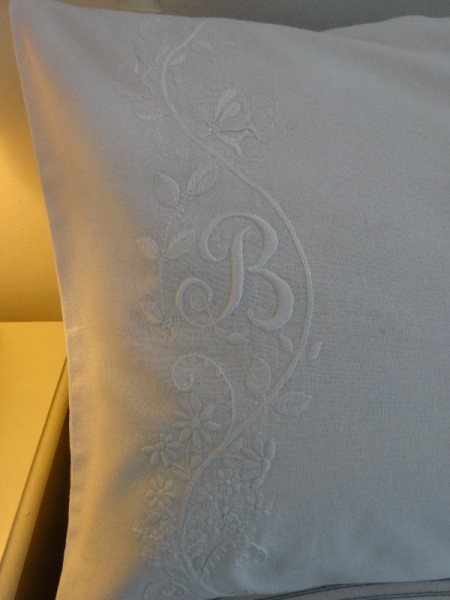
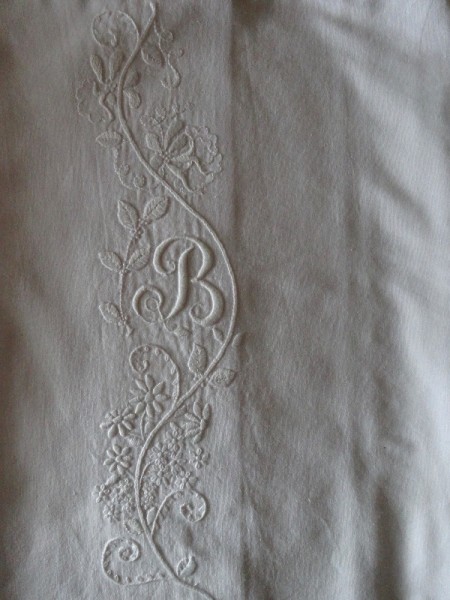
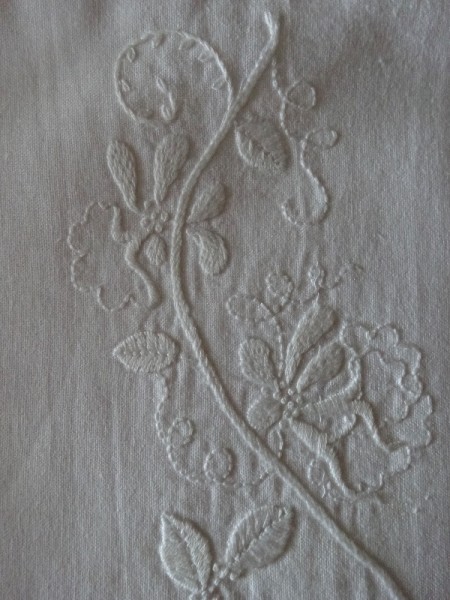
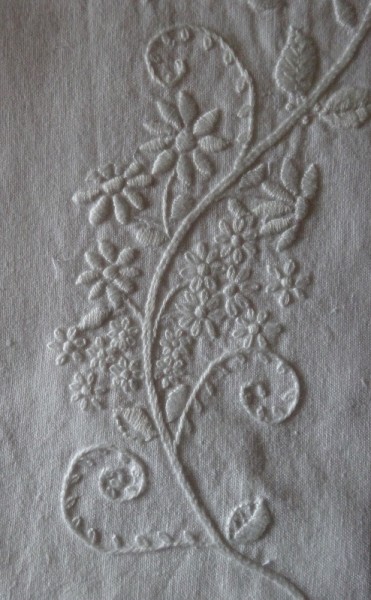
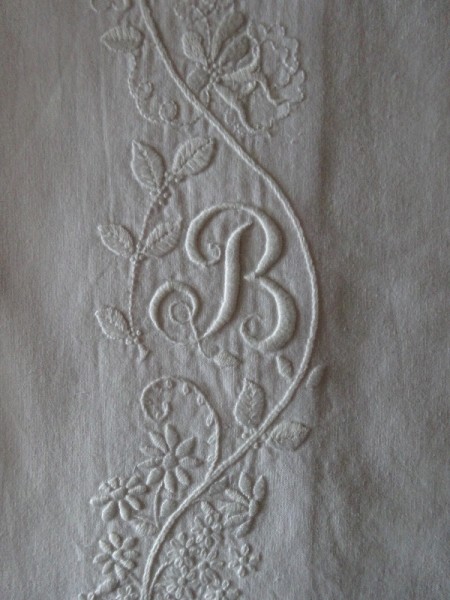
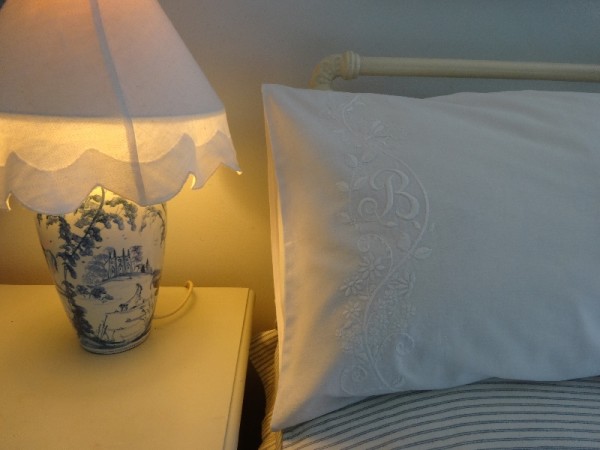
18 Comments
He sounds like a delightful English gentleman scholar of the Golden Age. It’s so good to know they still exist, and of course he is the perfect recipient for a beautiful piece of embroidery!
Yes, Rachel, you’re right, such people are very refreshing in today’s world of instant celebrity.
Your embroidery is magnificent and your story of Bruce made my morning extra special. Thank you.
Thank you Ann, I’m so glad you enjoyed hearing about Bruce.
What a beautiful thing.
You are kind Louise – especially as the pillowcase already looks well worn in from the photographs!
Wow. What a wonderful piece of embroidery and beautiful words. You have said so much about Bruce, but I can’t help thinking that you are only scratching the surface. I think that you could write his story…Bx
Scratching the surface indeed Becky – I had to leave many good stories out.
I should love to write more extensively about Bruce and perhaps one day I will.
Hello Mary – What an absolutely wonderful tale… such a visitor would be so welcome in my home too. I am imagining your trip to Italy, tiny cakes and coffee, Bruce’s tea at the Palazzo… fascinating… thank you so much for writing about your friend today. I love your intricate white on white embroidery, mystery and complexity combined….
Glad you enjoyed this Lydia. Surface celebrity can be so alluring but nothing as interesting as individuals like Bruce.
I read this post yesterday but wanted to come back and re-read today before commenting, but what is it possible to say about such an unusual person who treads so lightly on the world yet clearly leaves an indelible impression of love, light and intelligence on all those he touches. Why wait for William Dalrymple to write Bruce’s biography. I think you should do it Mary. (After your book on embroidery) x
What lovely things you do say, Penny. What wonderful encouragement. Thank you.
I enjoyed your post very much. I knew a couple of people who were of Bruce’s ilk and they certainly added richness to my life. I’m glad you found just the right thing to make for him and it’s wonderful to be certain that he will enjoy it.
Thank you for letting me know that you enjoyed this post. Now I must package the pillowcase up and get it to Bruce!
Mary, you and Bruce deserve a much, much wider audience. You’ve written tantalisingly about a very special person, and how he’s featured in your life, and one can foresee – in the manner of Charades – a book, a film, a play, a TV series about him – as well as about you and your embroideries – if you decided to put aside some of your valuable time and write, perhaps in the Alan Bennett genre if one is forced into categorisation, a few stories about people who matter to you. You remind me sometimes of me: my impossible domestic ambitions juxtaposed against a rich inner writing life which is almost, any day now, any second, about to begin as soon as I’ve finished that last quilt. Yes, knitting, patchwork, embroidery, homemaking, cooking, babysitting grandchildren are incredibly satisfying in the still under-rated realm of the domestic arts that Jane Brocket has raised in status, but one wonders sometimes whether these pursuits are, in the end, substitutes for a writing life which one longs to be doing doing full time.
You have a wonderful gift for telling a seamless story, despite threads leading off in many directions, that is satisfyingly and effortlessly transcended into something extraordinary, Mary. Looking forward to the next one.
Gosh – what a lot to take in Penny.
I know what you mean about just finishing the next quilt/jumper, etc., etc. and how that becomes a reason/excuse for postponing other more challenging aspirations. This is why I enjoy blogging – limiting time and space given to a subject is both useful and difficult – as you say threads lead off in different directions (and are often left hanging – perhaps to be picked up later…) Particularly intriguing is how I often start out intending to go in one direction and then find things go off in an altogether different direction. Perhaps you should be blogging, Penny!!!
What a delightful insight into a fascinating life – and yes, we need more, but please don’t stop stitching. White on white embroidery has a timeless quality, and yours, as always, is exquisite.
White on white embroidery can make for rather boring photos, so it’s good to hear that others enjoy seeing it. Thank you for this, Marge.
One Trackback
[…] news of the sudden death of a great and unique friend, Bruce Wannell, who I first blogged about here. Diagnosed with pancreatic cancer only in December, we expected him through till at least spring and […]